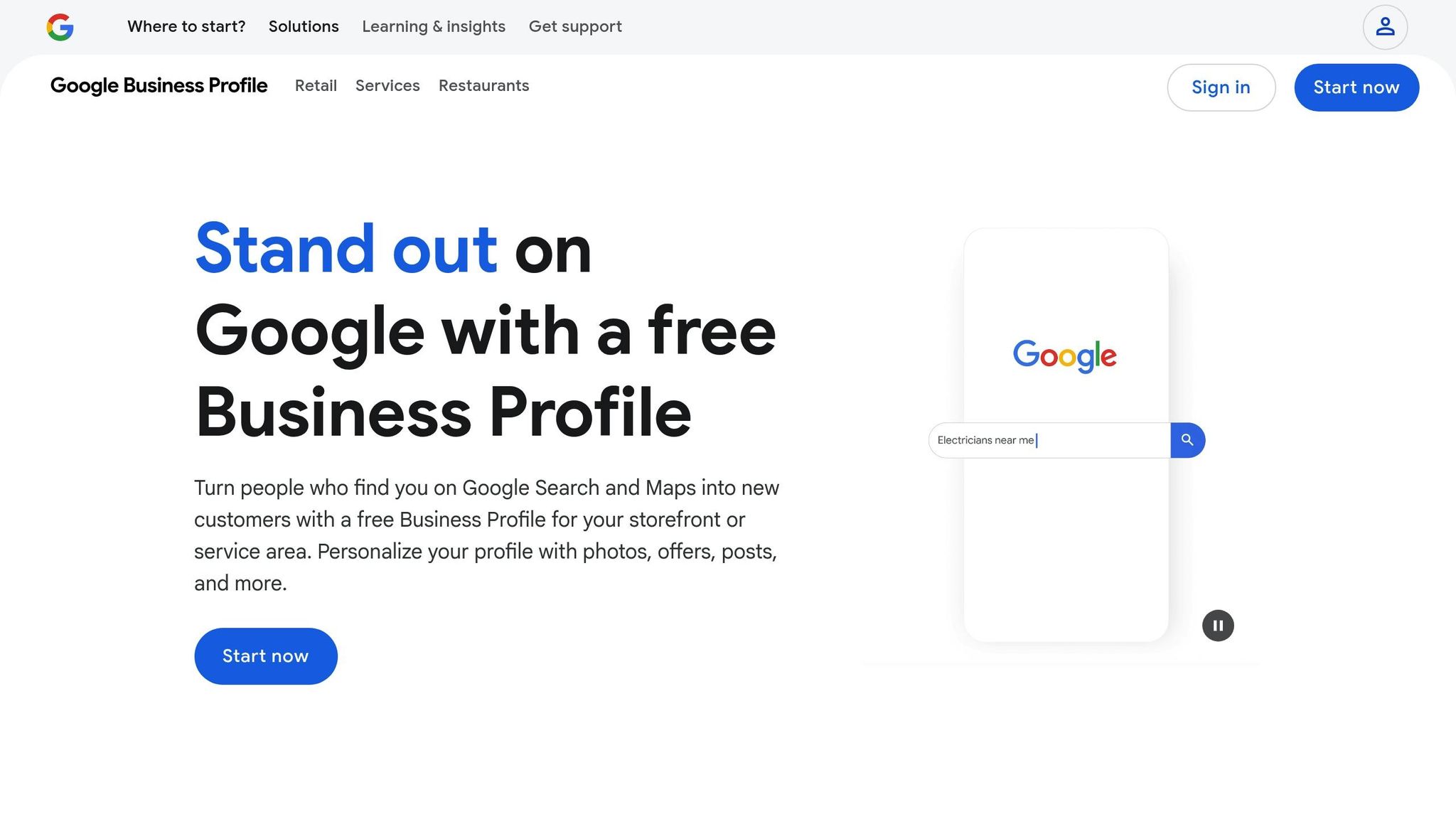Local SEO is essential for Austin businesses looking to thrive in a competitive market. With over 7,000 new businesses launched in 2024 and a $187 billion GDP, standing out in search results can directly impact your bottom line. Here’s why it matters:
- 46% of Google searches are for local business information, and 76% of users visit a business within 24 hours of searching nearby.
- Businesses in Google’s top 3 local results capture 44% of total clicks.
- 93% of consumers rely on online reviews, while 80% lose trust in businesses with incorrect information online.
To succeed, focus on these key strategies:
- Optimize your Google Business Profile: Verify your listing, maintain accurate Name-Address-Phone (NAP) details, and actively manage reviews.
- Target Austin-specific keywords: Use tools like Google Keyword Planner to identify terms tied to local areas, events, and customer needs (e.g., "best tacos South Congress").
- Build local citations and backlinks: List your business in directories like Yelp, Austin Chamber of Commerce, and partner with local bloggers and media.
- Use Schema Markup: Add structured data to your site to enhance visibility with rich snippets in search results.
- Track performance: Monitor rankings, website traffic, and conversion rates using tools like Google Analytics and Search Console.
Consistency across platforms, engaging with the community, and staying updated on local trends are crucial for long-term success. Local SEO isn’t just about visibility – it’s about connecting with the right audience at the right time.
Local SEO Tips: Must Dos, Nice to Dos, and Wastes of Time
How to Optimize Your Google Business Profile

Your Google Business Profile often serves as the first impression for potential customers in Austin. Make it count by optimizing your profile to turn searchers into visitors.
Claim and Verify Your Business Listing
Start by visiting the Google Business Profile site. If your business is already listed, select "Claim this business." If it’s not, create a new listing from scratch.
Verification is a crucial step. Most businesses verify through a postcard with a code, which typically arrives within 5–7 business days. Depending on availability, you might also verify by phone, email, or even by linking your Google Analytics account. Remember, unverified profiles are less likely to appear in local searches. Once verified, you’ll have full control over your business details and access to insights about customer interactions with your profile.
After verification, double-check that your business information is consistent across all platforms.
Keep Your NAP Information Accurate
NAP stands for Name, Address, and Phone Number. These three details must be consistent wherever your business appears online. Why? Because this consistency signals to Google that your business is legitimate and reliable.
"Update your profile with genuine reviews, local keywords, and consistent NAP data across directories." – Living Proof Creative
Your business name should match what’s on your storefront and official documents. For your address, follow the format recognized by the United States Postal Service. Avoid abbreviations like "St." unless that’s your official format. If you have a suite or unit number, include it. Also, use a local Austin phone number when possible to strengthen your local presence.
This attention to detail matters more than you might think. According to Think with Google, 60% of users don’t even click through to a company’s website; they simply grab the NAP information directly from search results. If your details are incorrect, you could lose potential customers before they even contact you.
If your business has multiple locations, maintaining consistency becomes even more critical. Tools like Yext can help you keep your NAP data synchronized across various directories and platforms automatically.
Once your business details are in order, shift your focus to collecting and managing customer reviews.
Get and Manage Customer Reviews
In Austin’s competitive market, customer reviews are not just about trust – they’re also key to boosting your local SEO. Reviews influence search rankings and directly impact buying decisions, so managing them should be a top priority.
Make it easy for customers to leave reviews. After completing a service or sale, follow up with an email or text containing a direct link to your Google Business Profile’s review section. Train your team to ask for reviews during positive interactions. A simple request after a great customer experience can lead to more feedback than you might expect.
Respond to every review, whether it’s glowing praise or constructive criticism. Thank customers for their positive feedback, and address any concerns raised in negative reviews with professionalism. Personalized, thoughtful responses show that you value customer input and are engaged with your community.
Stay proactive by monitoring reviews regularly. Set up alerts or check your profile weekly to catch new reviews as they come in. Negative reviews aren’t a disaster – they’re an opportunity to show off your customer service skills. A professional, well-handled response to criticism can often leave a better impression on potential customers than a string of perfect five-star reviews with no engagement.
How to Target Austin-Specific Keywords
Austin’s distinctive vibe and thriving business scene call for a tailored approach to keyword research. Using the right local keywords can make your business stand out when potential customers search for services nearby. This is especially important given that searches including phrases like "near me" or "where to buy" have surged by 200% over the past two years.
Research Austin Long-Tail Keywords
To start, put yourself in your customers’ shoes. People in Austin aren’t just searching for "coffee shop" – they’re looking for specifics, like "best coffee shop on South Lamar" or "coffee shops open late in East Austin." These long-tail keywords are goldmines for boosting local visibility.
Google Keyword Planner is a great tool to uncover these location-focused keywords. Begin with broad terms related to your business, then add "Austin" or specific neighborhoods such as "Downtown", "South by Southwest", or "Mueller." This will provide search volume data and suggest relevant phrases.
Don’t forget about voice search trends. Voice queries often mimic how people naturally talk, like "Where can I find authentic BBQ in Austin?" or "What’s the best live music venue open now?" With the rise of voice assistants, these conversational searches are becoming a big deal.
Local search trends in Austin show high interest in dining, live music, and services. For example, if you run a restaurant, consider targeting keywords like "live music restaurants Austin" or "best brunch spots Rainey Street." If you’re in the service industry, phrases like "Austin home repair services" or "plumbers near UT campus" could be a perfect fit.
Seasonal and event-based keywords are another avenue to explore. Austin’s packed event calendar, from SXSW to Austin City Limits, creates opportunities to target searches like "hotels near ACL Festival" or "food trucks during SXSW." Start researching these keywords well in advance to stay ahead of the game.
By focusing on these details, you’ll be able to seamlessly weave local keywords into your content.
Add Local Keywords to Your Content
Once you’ve nailed down your target keywords, the next step is incorporating them naturally into your website content. Avoid overloading your pages with keywords, as this can lead to penalties from search engines.
Your homepage is a prime spot for your primary Austin-focused keywords. For example, instead of a generic greeting, use something like, "Welcome to Austin’s premier farm-to-table restaurant in the heart of South Austin." This not only appeals to visitors but also signals to search engines that your business is rooted locally.
Consider creating dedicated pages for the specific neighborhoods you serve. For instance, a landscaping company could have pages like "Landscaping Services in Westlake Hills" or "Yard Design in Cedar Park." Each page should contain unique content that reflects the characteristics of that area.
Pay close attention to your meta descriptions and title tags. These snippets are what users see in search results, and they can significantly influence click-through rates. A title like "Best Tacos in Austin | Authentic Mexican Food on East 6th Street" is far more engaging and optimized than something generic like "Mexican Restaurant."
Blog posts are another effective way to incorporate local keywords. Write about Austin-specific topics that tie into your business. For example, a fitness studio might create posts like "5 Best Outdoor Workout Spots Along Lady Bird Lake" or "How Austin’s Heat Affects Your Workout Routine." Not only can these posts rank well in local searches, but they also establish your expertise and connection to the community.
Don’t overlook image optimization. Use local keywords in your image alt text and file names. Instead of a vague name like "IMG_1234.jpg", opt for something descriptive, such as "austin-bbq-brisket-franklin-style.jpg." This small step can help your images show up in local image searches and support your broader SEO strategy.
The key is to craft content that resonates with your Austin audience while naturally including the keywords they’re using to find businesses like yours. When done right, this approach will attract more qualified traffic from people actively searching for your services in Austin.
How to Build Local Citations and Backlinks
Creating strong local citations and backlinks is a key step in building trust for your Austin business. When reputable websites mention your business or link back to your site, it signals to search engines that your business is trustworthy. This is especially impactful when those mentions or links come from other Austin-based websites, as they carry extra weight in local search rankings.
Local citations refer to mentions of your business name, address, and phone number (NAP) across various websites. Backlinks, on the other hand, are clickable links that direct users to your website. Both are critical for boosting your local search rankings and establishing your business as a credible presence in the Austin community.
List Your Business in Local Directories
Getting your business listed in local directories is one of the most effective ways to build citations and improve your local SEO. These directories not only help customers discover your business but also provide search engines with consistent location data, which is essential for ranking well in local searches.
Start with the big players that influence local search rankings. Yelp is a must for businesses like restaurants and service providers. Make sure your Yelp profile is complete with high-quality photos, detailed descriptions, and your current operating hours. Other platforms to prioritize include Facebook Business, Bing Places, and Apple Maps.
For Austin-specific exposure, focus on directories that cater to the local community. The Austin Chamber of Commerce directory is a great place to start, as it connects you with other businesses and enhances your local credibility. TripAdvisor is especially useful for businesses in hospitality, dining, or entertainment, given Austin’s vibrant tourism scene.
You can also tap into industry-specific directories for added visibility. For example:
- Restaurants can benefit from listings on OpenTable and Zomato.
- Service businesses should consider platforms like Angie’s List (now Angi) and HomeAdvisor.
- Professional services can gain credibility through listings on Better Business Bureau and relevant trade associations.
Be meticulous about keeping your NAP details consistent across all platforms. Even small discrepancies, like using “Street” in one listing and “St.” in another, can confuse search engines and hurt your local SEO efforts. Additionally, update your listings regularly with accurate information, seasonal hours, and fresh photos. Many directories also allow you to include extra details like payment methods, parking options, and special features. Use these fields to stand out and provide customers with all the information they need.
Once your directory listings are in good shape, take the next step by collaborating with local bloggers and media outlets.
Partner with Local Bloggers and Media
Teaming up with local bloggers and media outlets is a fantastic way to earn high-quality backlinks that can significantly improve your local search rankings. These partnerships not only bring you backlinks but also help you connect with the Austin community on a deeper level.
Austin has a thriving local media scene, with plenty of outlets looking for compelling stories. For example:
- Austin Business Journal often highlights business developments and entrepreneurial success stories.
- Austin American-Statesman covers a variety of topics, from dining reviews to community-focused features.
- CultureMap Austin is ideal for businesses in lifestyle, dining, or entertainment, as it focuses on local culture.
To get noticed, pitch newsworthy angles about your business. This could be a new product launch, a unique partnership, or even an interesting story about how your business got started. Avoid generic press releases – craft personalized pitches that align with each publication’s audience and editorial style.
Local bloggers and influencers are another powerful resource. Austin has a variety of neighborhood-focused blogs and lifestyle influencers who frequently feature local businesses. For instance:
- Austin Monthly often showcases businesses across different categories.
- 365 Things to Do in Austin regularly highlights local attractions, restaurants, and services.
Sponsoring events is another effective way to earn backlinks. Austin’s bustling event calendar, from major festivals to local community gatherings, offers plenty of opportunities. When you sponsor an event, your business is often listed on the event’s website, complete with a direct link back to your site.
Community involvement can also lead to valuable backlinks. Partnering with organizations like Austin Pets Alive!, Keep Austin Beautiful, or the Austin Marathon often results in sponsor acknowledgments that include website links. These organizations tend to have strong local authority, making their backlinks especially impactful for SEO.
Finally, don’t overlook educational institutions. Partnerships with schools like the University of Texas at Austin or Austin Community College can yield backlinks from their .edu domains, which are particularly valued by search engines. You could collaborate through internships, guest lectures, or community projects to build these connections.
Building these relationships takes time and genuine effort. Focus on becoming an active and engaged member of the Austin community. Offer value through your expertise, sponsorships, or support, and you’ll naturally earn backlinks while strengthening your local presence. The goal is to be seen as a trusted part of the community, not just another business chasing publicity.
How to Add Local Business Schema Markup
Schema markup is a powerful yet often overlooked tool for businesses in Austin aiming to improve their local search rankings. This code helps search engines understand and display key details about your business – like your address, phone number, hours, services, and even customer reviews. When done right, schema markup can make your business stand out in search results by showing rich snippets with extra information, such as ratings and contact details. Think of it as giving search engines a clear, structured summary of your business, enhancing your local SEO efforts.
What Schema Markup Is and Why It Matters
Schema markup is essentially a piece of code that helps search engines interpret your business information. For Austin businesses, using local business schema markup is especially useful because it connects your business to location-specific searches. For example, if someone searches for "coffee shops near downtown Austin" or "plumbers in South Austin", schema markup improves your chances of appearing in those results with enhanced listings.
One major perk of schema markup is rich snippets. These are the eye-catching search results that include extras like star ratings, business hours, phone numbers, and even photos. Rich snippets not only make your listing more noticeable but also tend to get more clicks than standard search results.
Another benefit is the Google Knowledge Panel, the detailed information box that appears on the right side of search results for business-related queries. With complete schema markup, Google can pull detailed information about your business to populate this panel, giving you a prime spot on the search results page.
Schema markup also plays a role in improving your local SEO rankings. Search engines use this structured data to better understand your business’s relevance to local searches. For Austin businesses, this can mean better visibility for searches tied to specific neighborhoods like East Austin, Westlake, or the Domain.
Steps to Add Local Business Schema Markup
Adding local business schema markup to your website might sound technical, but it’s simpler than you think. The key is to include all the essential details that search engines need to recognize your Austin-based business.
Start by gathering the basics: your business name, full address (including ZIP code), phone number, website URL, operating hours, and a list of services. For Austin businesses, be specific about your service areas – whether you’re covering all of Austin, neighborhoods like Hyde Park or Zilker, or even nearby cities like Cedar Park and Round Rock.
To create your schema code, use Google’s Structured Data Markup Helper. Select "Local Business" as the data type, enter your website URL, and highlight elements like your business name, address, and hours. The tool will generate schema code based on the information you provide.
Once you have the code, add it to your website’s HTML. If you’re using WordPress, plugins like Schema Pro or Rank Math can simplify this process. For custom websites, you’ll need to insert the JSON-LD code into the <head> section of your homepage and any location-specific pages.
Make sure your schema includes Austin-specific details to maximize local SEO benefits. For example:
- Service Area: Specify neighborhoods or regions you serve, like Central Austin or the broader metro area.
- Business Category: Use the most specific category available. If you own a restaurant, choose "Restaurant" instead of the more generic "LocalBusiness."
- Reviews: Integrate aggregate rating data from your Google Business Profile to display star ratings in search results. Reviews are a big deal in Austin, where consumers often rely on them when choosing local businesses.
- Special Features: Highlight what makes your business stand out. For instance, if you have outdoor seating (a popular option in Austin’s climate), offer delivery, or accept specific payment methods, include these details. Restaurants can also add cuisine type and price range, while service businesses might note emergency availability or certifications.
After adding the schema, test it with Google’s Rich Results Test to ensure everything is working properly. Fix any errors or warnings to avoid issues with your rich snippets showing up.
Track your schema’s performance using Google Search Console. The "Enhancements" section will show how Google processes your structured data and flag any problems. Regular monitoring is essential, especially if you update your website or business details.
If your business has multiple locations, add schema markup to each location page with specific contact details and addresses. This helps search engines connect each location to relevant neighborhood searches.
Lastly, make sure your schema markup aligns with other local SEO strategies. Your NAP (Name, Address, Phone number) information should match exactly across your schema markup, Google Business Profile, and local directory listings. Consistency across these platforms strengthens your credibility and helps search engines display your information confidently in local search results. Combined with a well-optimized Google Business Profile and accurate local citations, schema markup can significantly boost your local SEO performance.
How to Track Local SEO Performance
Keeping tabs on your local SEO efforts is essential to understand what’s working and where adjustments are needed. By monitoring the right metrics, you can fine-tune your strategy and improve your local visibility. Let’s dive into the key metrics and tools you’ll need to measure your progress effectively.
Key Metrics to Monitor
Tracking specific metrics can help you evaluate the impact of your local SEO efforts. Here’s what you should focus on:
- Local search rankings: Keep an eye on your rankings across different ZIP codes in Austin to account for location-based variations. This will give you a clearer picture of your local visibility.
- Google Business Profile insights: These insights reveal how customers discover your business – whether through direct searches, category searches, or branded searches. Metrics like profile views, website clicks, and direction requests show how engaged potential customers are.
- Website traffic from local searches: Analyze how much of your site traffic comes from local searches. Look at organic traffic from Austin-area searches and identify which pages perform best for local keywords. Engagement metrics for location-specific landing pages are also crucial.
- Click-through rates (CTR): A strong CTR from local search results indicates that your listings are compelling. If your CTR is low, it might be time to improve your business descriptions, photos, or review ratings.
- Conversion rates from local traffic: This is where the rubber meets the road. Track how well local visitors convert through actions like calls, contact forms, or online purchases compared to other traffic sources.
- Review metrics: Reviews play a huge role in local search performance. Keep an eye on your average rating, total reviews, review velocity, response rates, and overall sentiment.
- NAP consistency: Ensure your Name, Address, and Phone (NAP) information is consistent across directories like Yelp, Yellow Pages, and industry-specific platforms. Inconsistent data can hurt your rankings.
Tools for Tracking Local SEO Results
Once you’ve identified the metrics to monitor, the right tools can help you gather actionable insights and streamline the process:
- Google Analytics 4: Use location-based segments to analyze Austin-area traffic. Create custom reports to track conversions from organic search and monitor local keyword performance. Geographic reports can help you uncover underserved areas.
- Google Search Console: This tool highlights how your website performs for local queries. The Performance report shows Austin-related keywords, click-through rates, and rankings. Geographic data pinpoints which areas generate the most impressions and clicks.
- Google Business Profile Insights: Dive into analytics related to your local listing. You’ll see how customers find you, what actions they take, and how you compare to similar businesses in Austin. Metrics like photo views and post engagement provide additional insights.
- Local rank tracking tools: These tools allow you to monitor rankings for location-specific searches, down to the neighborhood or ZIP code level. Track important local keywords and watch for changes over time.
- Call tracking software: Assign unique phone numbers to different marketing channels to measure which local SEO efforts are driving calls. This helps you pinpoint what’s working.
- Review monitoring platforms: These tools collect reviews from multiple sites and alert you to new feedback. They also help you track trends in sentiment and, in some cases, analyze competitors.
- Heat mapping tools: Visualize how visitors interact with your location-specific landing pages. These tools show click patterns and areas where users may encounter friction, helping you optimize for conversions.
For businesses looking for a more comprehensive solution, platforms like SearchX offer tools tailored to local SEO tracking. Their services help monitor critical metrics like local rankings and conversion rates, ensuring you stay on top of your performance. Learn more about their SEO solutions and tools for tracking 12 essential SEO metrics.
To stay consistent, monitor most metrics monthly and check critical indicators weekly. Automate reports where possible to save time and establish baseline measurements when starting your local SEO efforts. This way, you can track improvements over time, demonstrate ROI, and identify areas that need attention.
Conclusion: Growing Your Austin Business with Local SEO
Local SEO provides a solid roadmap for growing your business in Austin’s competitive market. By applying the strategies outlined earlier, you can connect with customers who are actively searching for services like yours.
Start with your Google Business Profile – ensure your NAP (Name, Address, Phone Number) details are accurate, actively manage customer reviews, and reflect genuine experiences to enhance your local search presence.
Focus on Austin-specific keywords, build citations, and earn backlinks that establish your business as a trusted part of the local community. Incorporating schema markup can also help your business stand out in search results by presenting key information in a more accessible way.
To stay ahead, monitor your progress regularly. Keep an eye on your local rankings, Google Business Profile insights, and conversion rates to adapt as the Austin market shifts. This ongoing attention will help you maintain momentum and adjust strategies as needed.
Remember, local SEO is a long-term commitment. While it may take 3–6 months to see noticeable changes, the effort pays off. Austin customers value businesses that actively engage with and serve their community.
Whether you’re running a food truck in South Austin or a law firm downtown, start with small, manageable steps and build from there. Consistency and authenticity tailored to your unique business will make all the difference.
FAQs
What are the best local SEO strategies for Austin businesses to boost their visibility?
To stand out in Austin’s competitive market, businesses can adopt a few key local SEO tactics:
- Keep your Google Business Profile up to date. Make sure your address, phone number, and business hours are correct. This boosts your visibility in local search results and on Google Maps.
- Incorporate Austin-specific keywords into your website. Use them in titles, meta descriptions, and content to better connect with local audiences.
- Encourage customer reviews on platforms like Google and Yelp. Positive feedback not only builds trust but also improves your rankings in local search.
- Collaborate with local websites. Partner with Austin-based directories, organizations, and businesses to earn backlinks and strengthen your community presence.
These strategies can help your business capture attention and draw in more local customers in Austin’s bustling market.
What are some common mistakes Austin businesses make when setting up their Google Business Profile?
A frequent misstep is neglecting to claim your Google Business Profile. Without it, your business might not show up in local search results – a missed opportunity to connect with potential customers. Another common oversight is leaving the profile incomplete. Missing details like business hours, an accurate address, or high-quality photos can make your business less appealing or even cause confusion.
On top of that, not keeping the profile updated is a recipe for outdated information, which can frustrate and mislead customers. To attract local customers in Austin, it’s crucial to fully optimize your profile and keep it regularly updated.
How does using schema markup give Austin businesses an edge in local SEO?
Schema markup is a game-changer for businesses in Austin looking to shine in search results. By providing search engines with detailed context about your content, it helps your business stand out. Think of features like displaying your business hours, customer reviews, or even your location directly on the search page – these rich results give users quick, useful information at a glance.
In a bustling, competitive market like Austin, schema markup can make your business easier for local customers to find when they’re searching for specific products or services. It’s a straightforward yet highly effective way to boost your online visibility and draw more foot traffic or inquiries your way.




